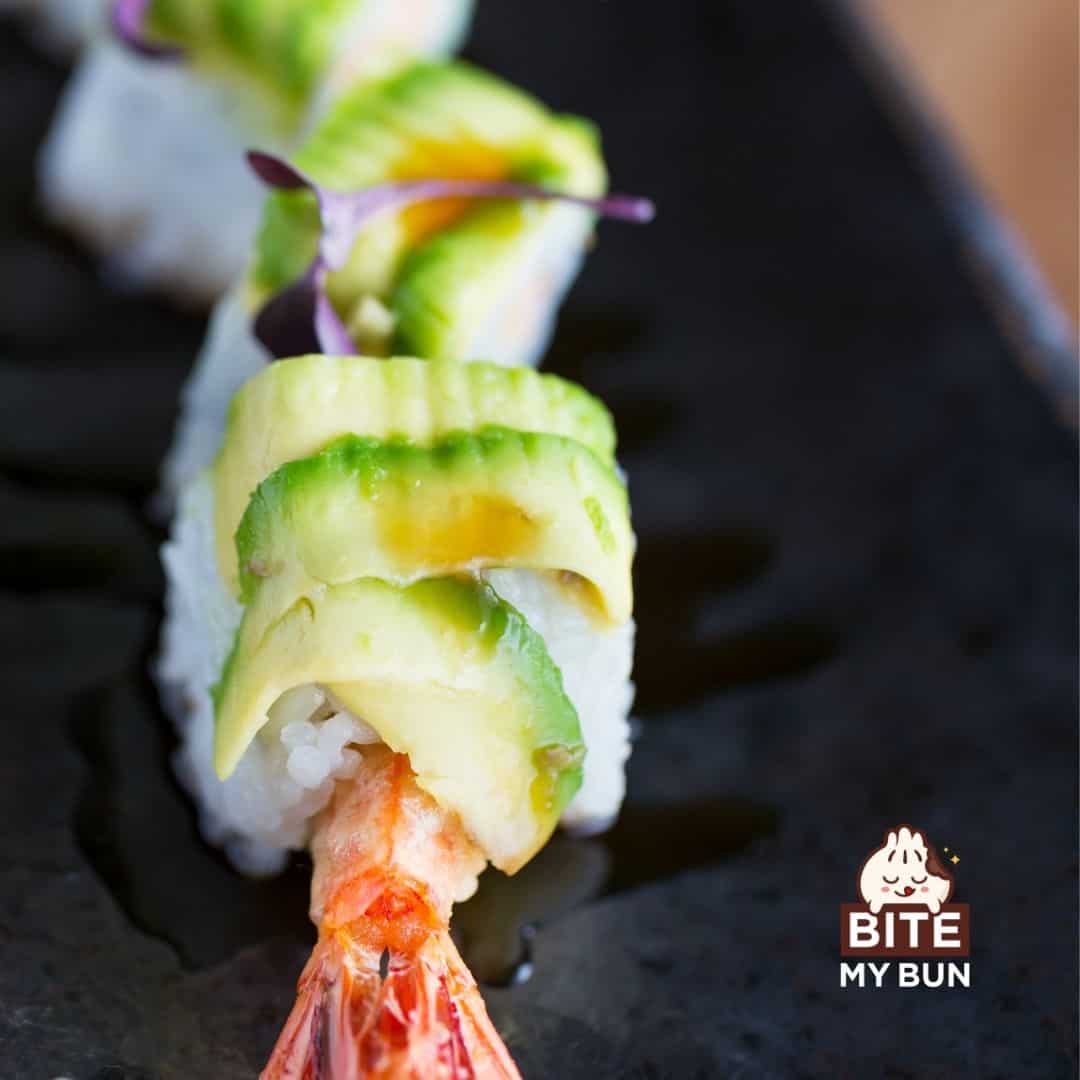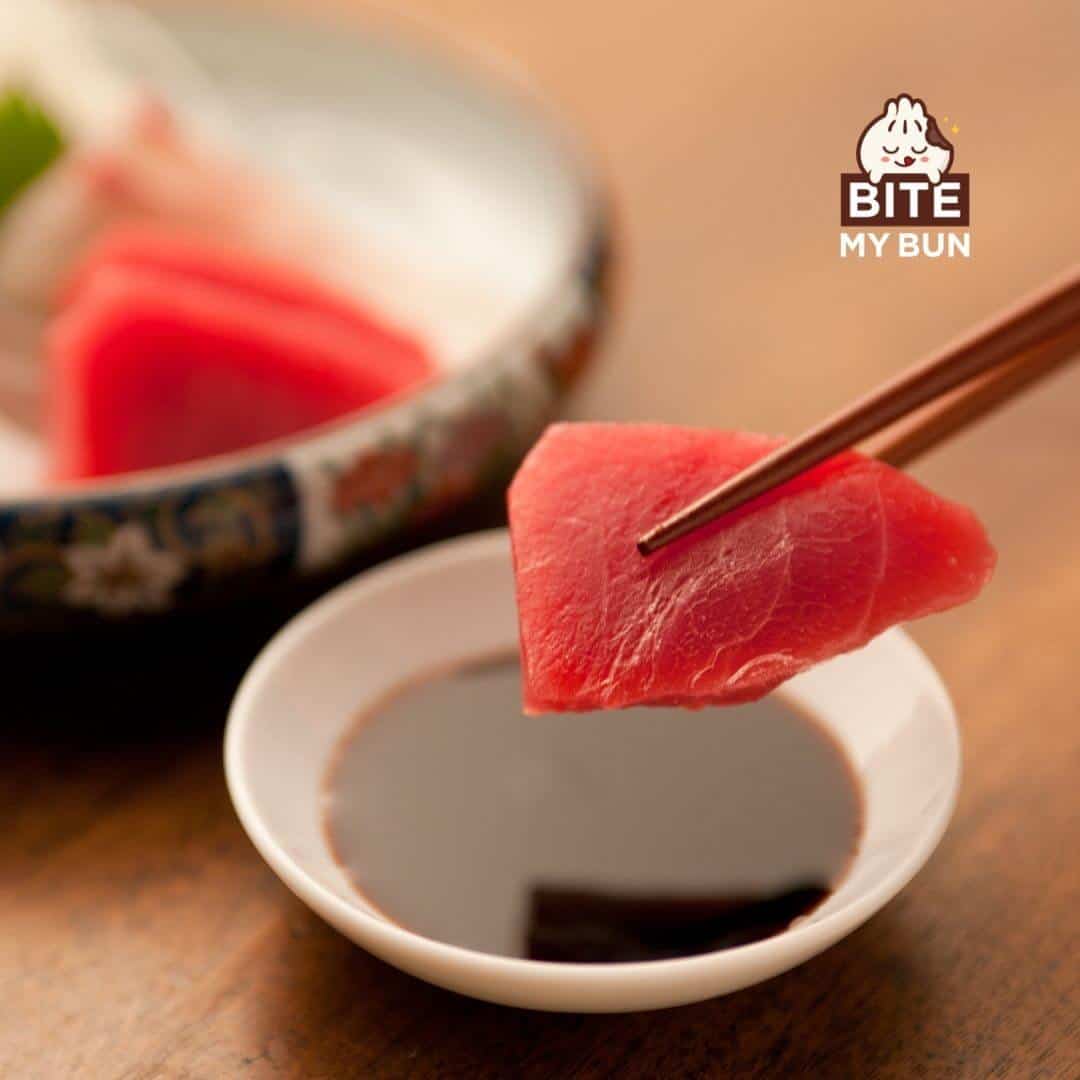Sushi Calories: Oh my! You should avoid some of these rolls
You probably love eating sushi, but it (unfortunately) comes with a price: calories.
The problem is that most of us eat the wrong kind of sushi. We don’t know how to order sushi, so we eat too much rice and not enough fish and vegetables.
Your typical 6-piece sushi roll contains between 200-250 calories. Maki rolls with fish, vegetables, and without extra sauces have the lowest calorie count, like the avocado roll. Sushi rolls with fried tempura batter or lots of extra fillings and sauces like the rainbow roll have the highest calorie count.

Even a standard sushi roll can be a healthy treat without breaking the calorie bank, as long as it doesn’t contain any fried ingredients. Most sushi is low-fat and low-calorie!
According to our survey, 73% of people are wondering how sushi fits into their diet, while 11% are about to order and wondering what sushi to get, so I’ll help you find a variety of low-calorie sushis and suggest some healthier alternatives you can pick right off the menu!
The big problem is hidden calories in many Western versions of sushi, like shrimp tempura rolls and rainbow rolls. These are jam-packed with fatty ingredients and lots of sauces that add to the total calorie count.
So if you want to consume fewer calories, the best option is sashimi, sushi with vegetables, brown rice (which you won’t often find in restaurants), and healthy fish. Skip anything fried or loaded with sauce.

Check out our new cookbook
Bitemybun's family recipes with complete meal planner and recipe guide.
Try it out for free with Kindle Unlimited:
Read for freeIn this post we'll cover:
- 1 Calorie counts for the most popular sushi rolls
- 2 Sushi roll calories explained
- 2.1 Shrimp tempura roll (508 calories)
- 2.2 Dragon roll ( 507 calories)
- 2.3 Rainbow roll (476 calories)
- 2.4 Eel avocado roll (372 calories)
- 2.5 Caterpillar roll (329 calories)
- 2.6 Philadelphia roll (320 calories)
- 2.7 Spider roll (317 calories)
- 2.8 Salmon avocado roll (304 calories)
- 2.9 Spicy tuna roll (290 calories)
- 2.10 California roll (225 calories)
- 2.11 Tuna roll (184 calories)
- 2.12 Avocado roll (140 calories)
- 2.13 Cucumber roll (135 calories)
- 2.14 Salmon sashimi (35 calories)
- 2.15 Tuna sashimi (31 calories)
- 3 Where do the calories come from?
- 4 Best low-calorie sushi fillings
- 5 How does sushi compare to other takeout?
- 6 Conclusion
Calorie counts for the most popular sushi rolls
There are many differences between a traditional roll and an American invention. One being…..calories.
I’ve listed the most famous sushi rolls here (from highest calories to lowest) so you can become an expert in sushi calories too.
The reality hurts when it comes to high-calorie rolls. But sometimes, a nice sushi roll is worth it, so don’t think you should never indulge. I added the % of your daily calorie intake (or Weight Watchers Smart Points if you’re into that) below for each roll so you can see what you’re eating.
These calorie counts are for 6-piece sushi rolls, which you’ll mostly get when ordering:
| Sushi roll | Calorie count | % of calorie intake | Weight Watchers Smart Points |
| Shrimp tempura roll | 508 | 25.4% | 19 |
| Dragon roll | 507 | 25.3% | 19 |
| Rainbow roll | 476 | 23.7% | 15 |
| Eel avocado roll | 372 | 18.6% | 14 |
| Caterpillar roll | 329 | 16.45% | 10 |
| Philadelphia roll | 320 | 16% | 11 |
| Spider roll | 317 | 15.8% | 12 |
| Salmon avocado roll | 304 | 15.2% | 10 |
| Spicy tuna roll | 290 | 14.4% | 9 |
| California roll | 225 | 11.25% | 8 |
| Tuna roll | 184 | 9.2% | 4 |
| Avocado roll | 140 | 7% | 6 |
| Cucumber roll | 135 | 7% | 6 |
| Average roll | 260 | 13.4% | 8 |
| Salmon sashimi | 35 per piece | 2% | 1 |
| Tuna sashimi | 31 per piece | 1.5% | 0 |
- Calorie count (per roll of 6 pieces)
- Percent of recommended daily calorie intake (female) based on 2000 calories/day
Did you expect the shrimp tempura roll (one of the most beloved sushi varieties) to be so unhealthy?

Sushi roll calories explained
Shrimp tempura roll (508 calories)

The shrimp tempura roll has the most calories because the shrimp is breaded and fried, providing a crunchy, delicious taste to shrimp. It contains 508 calories, 21 grams of fat, 64 carbohydrates, and 20 grams of protein.
While this sushi has the most calories, adventurous sushi lovers will definitely order it. There’s no doubt it’s one of the tastiest sushi rolls.
Dragon roll ( 507 calories)

The dragon roll is packed with tasty ingredients, but it’s fatty and high in calories. It contains 507 calories, 18 grams of fat, 10 grams of protein, and 66 grams of carbohydrates.
This roll contains delicious tempura shrimp, eel, cucumber, avocado, and tasty roe. But it’s covered in a thick (and unhealthy) sauce.
Rainbow roll (476 calories)

For those who want a bit of everything, the rainbow roll is the one to look for. It contains 476 calories, 16 grams of fat, 50 grams of carbs, and 33 grams of protein.
This sushi roll is classified as one of the most varied and protein-packed rolls because of the different types of fish on top. And while it’s high in calories, it’s a colorful and flavorful meal.
Eel avocado roll (372 calories)

Eel is chewy and one of sushi’s most fatty fish. The eel avocado roll contains 372 calories, 17 grams of fat, 31 grams of carbohydrates, and 20 grams of protein.
This roll is packed with protein, and although that’s a good thing, it needs a sophisticated sushi palate because its taste isn’t appealing to everyone.
Caterpillar roll (329 calories)

The caterpillar roll got its name from the avocado slices it’s topped with. It has 329 calories, 5 grams of fat, 60 grams of carbohydrates, and 9 grams of protein.
This roll generally includes eel, tobiko (fish roe), and cucumber in addition to the avocado.
Philadelphia roll (320 calories)

You’ll find salmon and cream cheese in the Philadelphia roll, making it one of the more calorie-laden sushi rolls. It has 320 calories, 8 grams of fat, 32 grams of carbohydrates, and 8 grams of protein.
If you like the taste of cream cheese with seafood, it’s a nice comfort roll to order.
Spider roll (317 calories)

The spider roll consists mainly of battered crab, which adds flavor and calories to a roll that’s otherwise pretty basic. It has 317 calories, 12 grams of fat, 38 grams of carbohydrates, and a protein content of 13 grams.
The fried crab adds fat, but it’s still a very famous and delicious roll.
Salmon avocado roll (304 calories)

The salmon avocado roll has “health advantages” written all over it. There are 304 calories in this sushi roll, 8.4 grams of fat, 42 grams of carbohydrates, and 13 grams of protein.
Since it’s full of omega 3s and good fats, it’s fantastic!
Also read: these sushi rolls are great to eat if you’re looking for some without avocado
Spicy tuna roll (290 calories)

The spicy tuna roll has more pizzazz and spice than the standard tuna roll. It contains 290 calories, 11 grams of fat, 26 grams of carbohydrates, 24 grams of protein.
The delicious “spiciness” comes from the use of mayonnaise (which contributes to the calorie count), hot sauce, and green onions.
California roll (225 calories)

The California roll is one of those classics everyone loves. It has 225 calories, 7 grams of fat, 28 grams of carbohydrates, and 9 grams of protein.
It’s the ideal roll for beginners making sushi for the first time. It’s also a nice light meal.
Tuna roll (184 calories)

With the added protein, the tuna roll is still pretty simple. It has 184 calories, 2 g of fat, 27 g of carbohydrates, and 24 g of protein.
This roll is an excellent choice with light fish without the “spicy” tuna element.
Avocado roll (140 calories)

The avocado sushi roll includes the smallest quantity of calories, as it’s one of the most basic ones to order. There are 140 calories in an avocado roll, 5.7 grams of fat, 28 grams of carbohydrates, and 2.1 grams of protein.
This roll is light and perfect for those who don’t enjoy fish. It’s also vegetarian and vegan-friendly, so you can’t go wrong with it!
Also read: sushi, a beginners guide
Cucumber roll (135 calories)

The cucumber roll is the healthiest choice when it comes to watching calories. Depending on how many pieces the restaurant cuts them into, they’ll be 16 to 22 calories each, which comes down to 135 calories in a roll.
It’s basically just some pieces of cucumber in rice wrapped in seaweed, with just a little sushi vinegar to season the rice.
I think everyone on a diet should at least order a roll of these when going to a restaurant!
Salmon sashimi (35 calories)

Salmon sashimi is healthy and the perfect low-calorie option. It has the lowest calorie count on this list but it’s not maki sushi so there’s no rice.
One ounce of raw salmon has about 25-40 calories. I’m not calculating the calories per roll, but rather calories per piece since it’s served in pieces. So a piece of sashimi usually contains about 40-50 calories and 20 grams of protein.
It’s a great source of Omega 3 fatty acids, as well as all the B vitamins!
Tuna sashimi (31 calories)

This rice-free raw tuna sashimi also has one of the lowest calorie counts on the sushi menu. It has about 31 calories per serving (per piece).
Tuna is also a very low-fat fish, so a serving contains only 0.1 grams of fat and 11 mg of cholesterol.
Where do the calories come from?
Nori, rice, veggies, fish; it seems like this is all relatively healthy. So, where do the calories come from? Which ingredients are healthy and which are unhealthy?
White rice
White rice is public enemy no.1 for calories in sushi. After all, the main component of sushi is rice!
White rice is a problematic ingredient because it’s low in fiber and a source of refined carbs. So it’s just a source of refined carbs with no real health benefits. When you consume too many refined carbs, your blood sugar rises, and the body experiences inflammation.
Sushi rice is also low in fiber, and combined with vinegar and sugar, it causes the body to break it down quickly. This leads to insulin spikes and is dangerous for diabetics.
Also, white rice is processed food, so the nutrients are stripped.
If you choose brown rice sushi, it’s a much better option because it contains more fiber and fewer calories.
Sushi vinegar contains sugar
Rice vinegar is exceptional and perfect for digestion, but it also helps the body absorb nutrients from other foods you consume. It’s great for weight loss and it balances some of the peskier ingredients in sushi, such as soy sauce, which is high in sodium.
Now, soy sauce is really salty and you might want to skip it if you’re trying to watch the amount of salt you eat since there are other low-sodium options available. You can usually find low-sodium soy sauce.
Sushi rice is normally seasoned with sushi vinegar, which also contains sugar. But you can just use rice vinegar instead.
Since we’ve identified advantages for some of the most commonly used ingredients, we still need to tackle the white rice problem.
White rice is a no-go if you want to lose weight. But sushi can’t be sushi without rice and I have to say it’s bull, as much as I agree with it. There are plenty of excellent sushi rice options that leave sushi in its purest, most holy form to be sushi.
Or you can just choose nigiri sushi and sashimi with less rice.
I’ve also got these 5 sushi without rice recipes you can make at home, or read on for more healthy rice tips.
Tempura & sauces
Unfortunately, tempura batter is full of calories. If you’re eating fried shrimp rolls, the fatty batter cancels out any of the shrimp’s health benefits.
Fillings and toppings are also big sources of calories. Many fillings are low in protein content but high in fat. So when you choose sushi with high-fat sauces, you’re adding calories.
Takeaway: Many popular sushi rolls contain lots of rice, small amounts of seafood, and veggies, and instead, are loaded with fatty sauces. So you consume lots of calories, and little fiber and protein, so you don’t feel full and overeat.
Best low-calorie sushi fillings
- Cucumber
- Avocado
- Pickled vegetables
- Mackerel (fish)
- Salmon (but skip the sauce)
- Radish
- Boiled shrimp (not fried in tempura batter)
- Raw crab & imitation crab
- Tuna
- Sea vegetables
- Carrots
- Seabass (fish)
- Whitefish
Also read: how does sushi fit into my diet? Types of diets explained
How does sushi compare to other takeout?
When you choose sushi for takeout, you may be consuming fewer calories. But you can easily exceed 1,000 calories per meal, depending on how much you eat.
Sure, compared to a fast-food-type beef burger with tons of mayo and tasty fillings, and a side of french fries, plus soda, sushi seems healthy. It’s healthier and lower in calories than common Chinese takeout foods. It’s also healthier than most microwave meals.
But is it the healthiest takeout food, as many would have you believe?
There are some really healthy takeaway foods, including vegetable soup, tom-yum soup, meat-free salads, stir-fried meats, grilled meats, fish dishes, veggie dishes, and steamed meats with vegetable sides.
Sushi is definitely on the healthier side of the takeout spectrum. It’s usually lower in fat and calories than common takeout meals like pizza, sandwiches, subs, Chinese meaty dishes, burgers, chicken strips & wings, curries, etc.
If you have to choose between the foods listed above, choose sushi. But be conscious about sauces, skip the soy sauce, and choose raw fish or veggies instead of other meats and fried fillings.
Conclusion
Sushi may have healthy options, but the average roll will contain a lot of calories, and some are hidden in the rice and sauces so take extra care when ordering rolls.
Also read: is sushi good for losing weight?
Check out our new cookbook
Bitemybun's family recipes with complete meal planner and recipe guide.
Try it out for free with Kindle Unlimited:
Read for freeJoost Nusselder, the founder of Bite My Bun is a content marketer, dad and loves trying out new food with Japanese food at the heart of his passion, and together with his team he's been creating in-depth blog articles since 2016 to help loyal readers with recipes and cooking tips.
